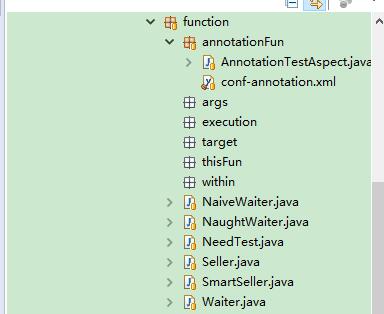@annotation()概述
@annotation表示标注了某个注解的所有方法。
下面通过一个实例说明@annotation()的用法。 AnnotationTestAspect定义了一个后置切面增强,该增强将应用到标注了NeedTest的目标方法中。
实例
代码已托管到Github—> https://github.com/yangshangwei/SpringMaster

首先我们先自定义一个注解@NeedTest。
如何自定义注解请参考Java-Java5.0注解解读
|
1
2
3
4
5
6
7
8
9
10
11
12
13
14
15
16
17
18
19
20
21
22
23
24
25
26
|
package com.xgj.aop.spring.advisor.aspectJ.function;import java.lang.annotation.Documented;import java.lang.annotation.ElementType;import java.lang.annotation.Retention;import java.lang.annotation.RetentionPolicy;import java.lang.annotation.Target;/** * * * @ClassName: NeedTest * * @Description: 自定义注解@NeedTest * * @author: Mr.Yang * * @date: 2017年8月26日 下午11:19:12 */// 声明注解的保留期限@Retention(RetentionPolicy.RUNTIME)// 声明可以使用该注解的目标类型@Target(ElementType.METHOD)@Documentedpublic @interface NeedTest { // 声明注解成员 boolean value() default false;} |
下面我们定义接口 Waiter
|
1
2
3
4
5
|
package com.xgj.aop.spring.advisor.aspectJ.function;public interface Waiter { public void greetTo(String clientName); public void serverTo(String clientName);} |
接口实现类 两个NaiveWaiter 和 NaughtWaiter
|
1
2
3
4
5
6
7
8
9
10
11
12
13
14
15
16
|
package com.xgj.aop.spring.advisor.aspectJ.function;public class NaiveWaiter implements Waiter { @NeedTest(true) @Override public void greetTo(String clientName) { System.out.println("NaiveWaiter:greet to " + clientName); } @Override public void serverTo(String clientName) { System.out.println("NaiveWaiter:server to " + clientName); } public void smile(String clientName, int times) { System.out.println("NaiveWaiter:smile to " + clientName + " " + times + " times"); }} |
|
1
2
3
4
5
6
7
8
9
10
11
12
13
14
15
16
|
package com.xgj.aop.spring.advisor.aspectJ.function;public class NaughtWaiter implements Waiter { @Override public void greetTo(String clientName) { System.out.println("NaughtWaiter:greet to " + clientName); } @NeedTest(true) @Override public void serverTo(String clientName) { System.out.println("NaughtWaiter:server to " + clientName); } public void joke(String clientName, int times) { System.out.println("NaughtyWaiter:play " + times + " jokes to " + clientName); }} |
我们可以看到 NaiveWaiter#greetTo()方法标注了@NeedTest, NaughtWaiter#serverTo()也标注了@NeedTest,我们的目标就是将后置增强织入到这两个标注了@NeedTest的方法中。
接下来编写切面的横切逻辑
|
1
2
3
4
5
6
7
8
9
10
11
12
13
14
15
16
17
18
19
20
21
|
package com.xgj.aop.spring.advisor.aspectJ.function.annotationFun;import org.aspectj.lang.annotation.AfterReturning;import org.aspectj.lang.annotation.Aspect;/** * * * @ClassName: AnnotationTestAspect * * @Description: 切面 、 后置增强 ,@annotation表示标注了某个注解的所有方法 * * @author: Mr.Yang * * @date: 2017年8月26日 下午11:23:53 */@Aspectpublic class AnnotationTestAspect { @AfterReturning("@annotation(com.xgj.aop.spring.advisor.aspectJ.function.NeedTest)") public void needTest() { System.out.println("needTest() executed,some logic is here"); }} |
接下来通过Spring自动应用切面,配置文件如下
|
1
2
3
4
5
6
7
8
9
10
11
12
13
14
15
16
17
18
19
|
<?xml version="1.0" encoding="UTF-8"?><beans xmlns="http://www.springframework.org/schema/beans" xmlns:aop="http://www.springframework.org/schema/aop" xmlns:xsi="http://www.w3.org/2001/XMLSchema-instance" xsi:schemaLocation="http://www.springframework.org/schema/beans http://www.springframework.org/schema/beans/spring-beans.xsd http://www.springframework.org/schema/aop http://www.springframework.org/schema/aop/spring-aop.xsd"><!-- 使用基于Schema的aop命名空间进行配置 --> <!-- 基于@AspectJ切面的驱动器 --><aop:aspectj-autoproxy/> <!-- 目标Bean --><bean id="naiveWaiter" class="com.xgj.aop.spring.advisor.aspectJ.function.NaiveWaiter"/><bean id="naughtWaiter" class="com.xgj.aop.spring.advisor.aspectJ.function.NaughtWaiter"/><!-- 使用了@AspectJ注解的切面类 --><bean class="com.xgj.aop.spring.advisor.aspectJ.function.annotationFun.AnnotationTestAspect"/></beans> |
最后编写测试代码:
|
1
2
3
4
5
6
7
8
9
10
11
12
13
14
15
16
17
18
19
20
|
package com.xgj.aop.spring.advisor.aspectJ.function.annotationFun;import org.junit.Test;import org.springframework.context.ApplicationContext;import org.springframework.context.support.ClassPathXmlApplicationContext;import com.xgj.aop.spring.advisor.aspectJ.function.Waiter;public class AnnotationTestAspcetTest { @Test public void test() { ApplicationContext ctx = new ClassPathXmlApplicationContext( "com/xgj/aop/spring/advisor/aspectJ/function/annotationFun/conf-annotation.xml"); // 必须是接口类型,否则抛类型转换异常 Waiter waiter = (Waiter) ctx.getBean("naiveWaiter"); // 因为greetTo标注了@NeedTest,因此会被后置增强 waiter.greetTo("XiaoGongJiang"); waiter.serverTo("XiaoGongJiang"); Waiter naughtWaiter = (Waiter) ctx.getBean("naughtWaiter"); // serverTo标注了@NeedTest,因此会被后置增强 naughtWaiter.serverTo("XiaoGongJiang"); }} |
运行结果:
2017-08-27 01:24:22,551 INFO [main] (AbstractApplicationContext.java:583) - Refreshing org.springframework.context.support.ClassPathXmlApplicationContext@6ac604: startup date [Sun Aug 27 01:24:22 BOT 2017]; root of context hierarchy
2017-08-27 01:24:22,647 INFO [main] (XmlBeanDefinitionReader.java:317) - Loading XML bean definitions from class path resource [com/xgj/aop/spring/advisor/aspectJ/function/annotationFun/conf-annotation.xml]
NaiveWaiter:greet to XiaoGongJiang
needTest() executed,some logic is here
NaiveWaiter:server to XiaoGongJiang
NaughtWaiter:server to XiaoGongJiang
needTest() executed,some logic is here
从输出结果中可以看出,切面被正确的织入到了标注有@NeedTest注解的方法中。
以上为个人经验,希望能给大家一个参考,也希望大家多多支持服务器之家。
原文链接:https://artisan.blog.csdn.net/article/details/77619875















